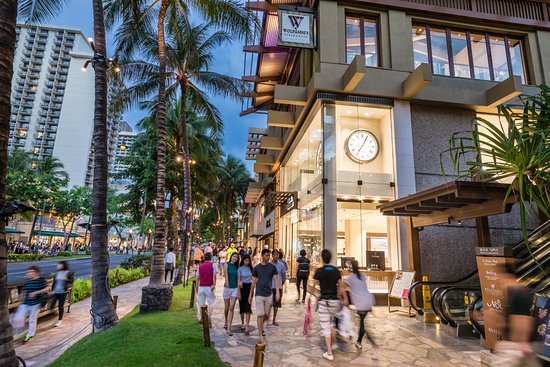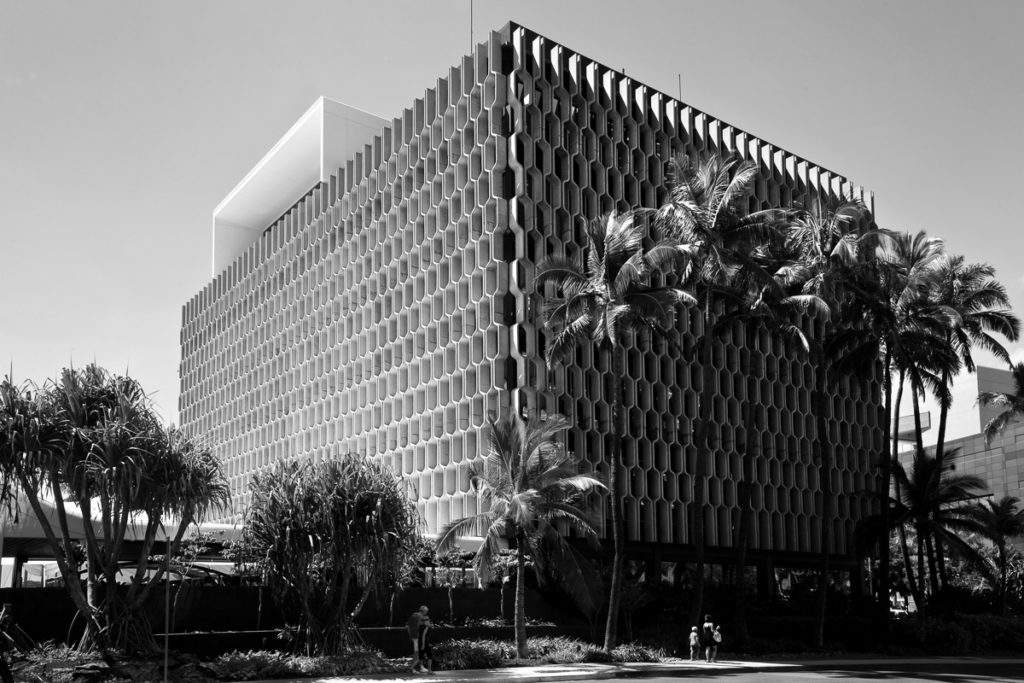
‘Lucky you live Hawaii’ and lucky indeed, as a sometime resident of the 50th state for over 40 years- on Maui and the big island of Hawaii, but mostly on Oahu and in Honolulu proper. One of my first visual recollections of the built environment is of the IBM Building on Ala Moana Boulevard, behind which my offices were sited. It was the view of this iconic building that I saw at least twice a day, coming and going from work, that served to imprint forever the work of the likewise iconic architect Vladimir Ossipoff (1907-1998). The building itself survives, where, sadly, the verdant charms of the garden office complex where my work was located does not. Indeed, with so much of the low-rise development in this portion of Kakaako now given over in the last few years to a forest of high rises, the IBM Building is a fortunate survival. Timelessness is a cliché given out too frequently, and often for those things though extant are trapped ineluctably in their own time. The IBM Building, indeed so much of Ossipoff’s work, properly defines timelessness, as an aesthetic transcendence that, though it were designed and built some six decades ago, nevertheless appears of current moment- au courant, with a contemporary resonance and absent anachronisms that fix it irretrievably in a specific (past) time.
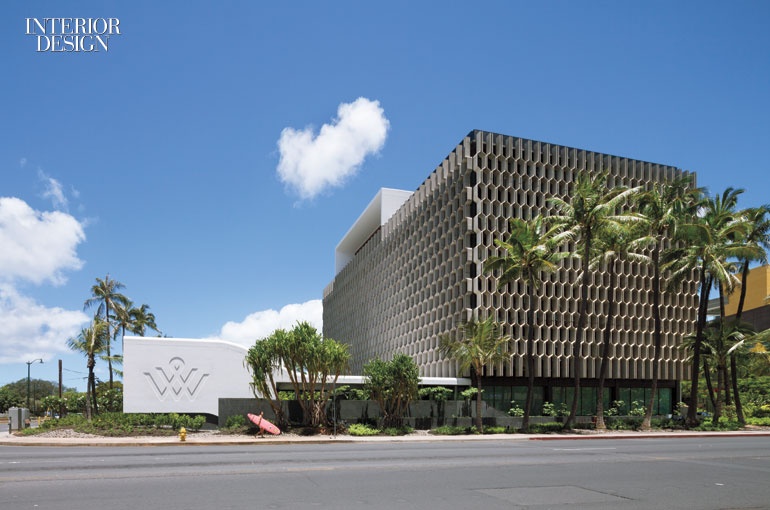
Unfortunately, while the IBM Building on its own is wonderful in very many ways, the development that has recently grown up around it works very very hard to diminish it. Although trained in a beaux-arts tradition, Ossipoff escaped this outmoded imagist school of architecture and emerged very much an architectural realist more akin to modernists Le Corbusier and Mies Van Der Rohe, very nearly always rendering his designs in a contemporary idiom and specific to the sites where they would be built. As constructed and as it has existed for most of its life, the building is a landmark, with its distinctive screened surface able to be viewed from all four sides, and sited properly in the center of the land area it occupies, with an adequate set back to give it, shall we say, presence. Now, it is dwarfed by the buildings that surround it. It also serves as the showroom location for the developer who has wrought this unfortunate change to the local environment, who has also grafted onto the Ala Moana Boulevard front a sad and overlarge excrescence that serves as entryway and display area for the developer’s current and pending projects.
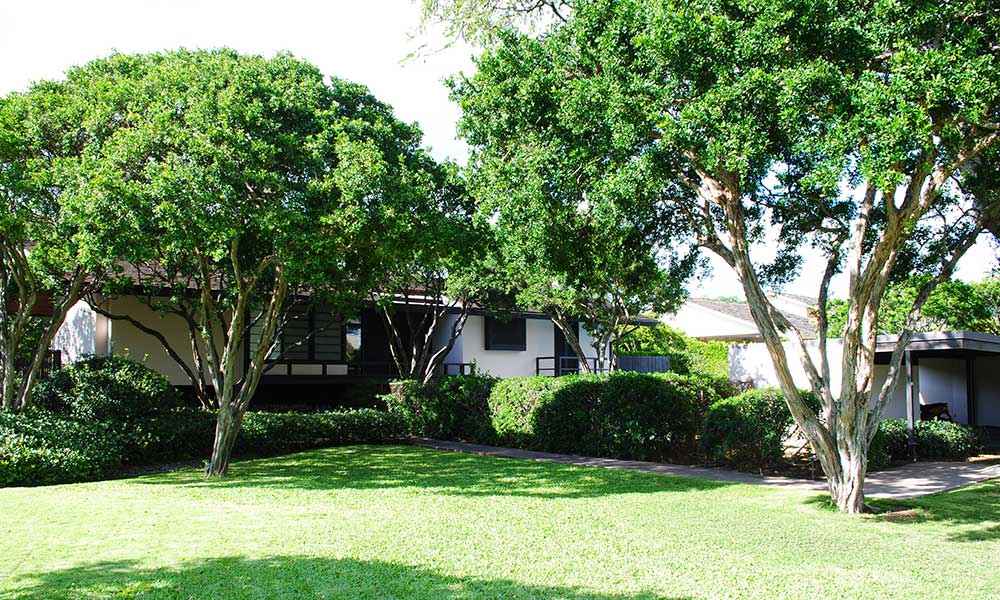
Although I’ve introduced this essay with a consideration of the IBM Building, what actually put me in mind of Ossipoff was a visit to one of his residential commissions, what’s come to be known as the Goodsill house, completed by Ossipoff in 1954. For a number of years, this extraordinary home has been owned by the Honolulu Museum of Art and served to house its director. Sadly, the museum can no longer afford to do this, and is now offering the house for sale. Would that I could afford to purchase it. While at first sight it isn’t particularly obvious that it bears any aesthetic connection with the IBM Building, it nevertheless has some similarities. Firstly and perhaps most prominently, it is properly sited on a large building lot that extends to nearly a half an acre. The gradient was basically unchanged from its original state, and the house as sited seems organic and embracing its setting. In an effort to preserve the house as built it has been given an historic designation. I have though been given to understand that some interest has been shown in the property by certain people who would strip the house of its designation, thereby giving them the opportunity to tear it down and build something larger in its place. I shudder to think that anyone could bring themselves to consider much less mouth such wantonly irresponsible spoliation.
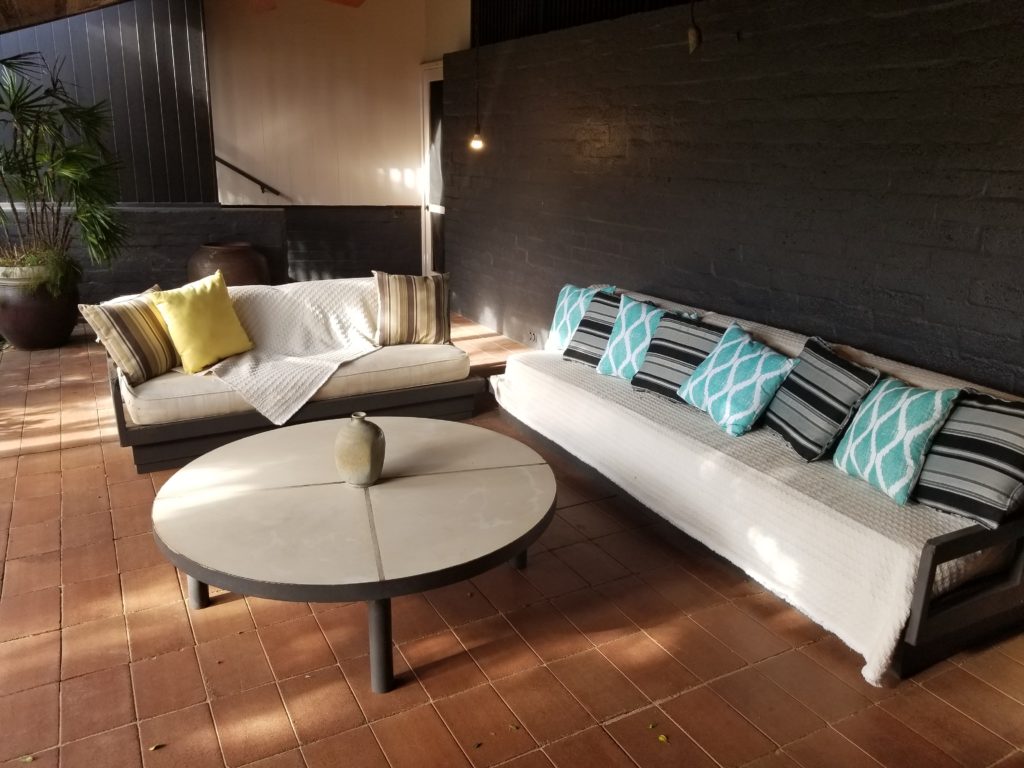
That aside, it was a joy for me to make my way around. With an open full-length vista from the living area to the back garden, the front portion of the house fully embraces the softly comfortable weather as well as the tropical beauty of what is largely a natural setting. This is then joined to an adjacent outdoor seating area, covered by a wide overhang. Angled from this is the bedroom wing, privately separated from the living area, and sited, as with the rest of the house, to take advantage of the prevailing trade winds blowing from the north east to the southwest.
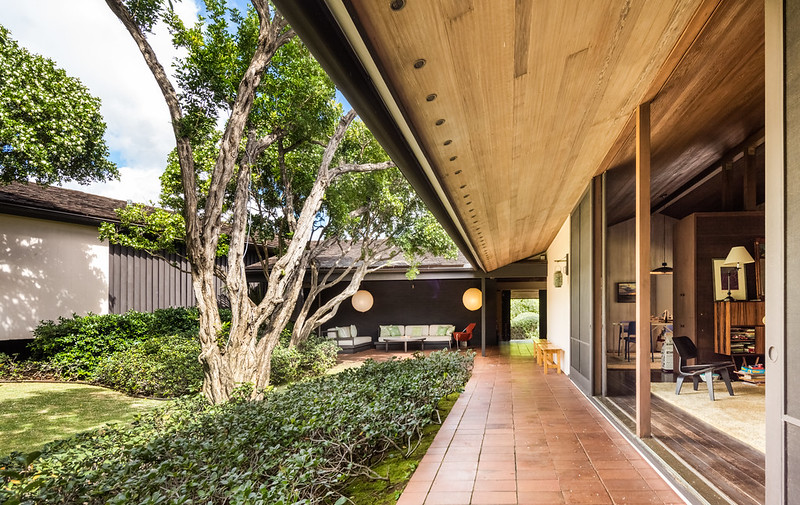
All of this- an organcism specific to its site is what immediately joins, for instance, the Goodsill house to the IBM Building. What is less apparent, but very obvious when the body of Ossipoff’s work is considered, is his contribution toward the development of a specifically Hawaiian design aesthetic. Ossipoff worked consciously throughout his 60-year career in Hawaii synthesizing an endemic Polynesian vernacular with the strong influences of the far east enjoyed by the state and introducing contemporary influences in domestic architecture expressed on the mainland by older contemporaries Richard Neutra and Rudolph Schindler. The recognition of Ossipoff’s body of work was recognized in an extraordinary exhibition hosted by the Honolulu Museum of Art in 2007 curated by Dean Sakamoto of Yale University, who masterfully prepared the essays and catalog that accompanied the exhibition.
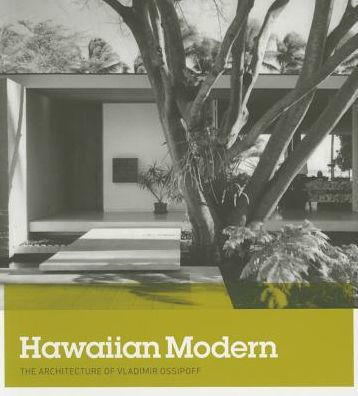
Fortunately, very much of Ossipoff’s work survives and while it does maintain its own integrity, the state as a whole is, shall we say, in flux, and as with the area surrounding the IBM Building, is influenced strongly by changes in economic forces, oftentimes baleful in their effects. Through most of Ossipoff’s working life, the state of Hawaii with its trading center at Honolulu was largely agricultural, with the so-called Big Five planters in control of the main crops that represented the lion’s share of the state’s gross domestic product. Beginning well before his death in 1998, plantation agriculture was waning and virtually disappeared, and displaced almost entirely by tourism as the engine driving the state’s economy. Although occluded by the large numbers of tourists in the state at any given time, the permanent population has declined, with increasing numbers of people leaving, looking for work on the US mainland. However, while a waning population might be thought to produce an excess of housing stocks resulting in falling prices, inward investment from Japan in the 1980’s and early 1990’s, and from an economically robust China in the last 15 years has resulted in huge price appreciation- and the development of innumerable high rises for sale specifically to first Japanese, and more recently Chinese investors.
Despite the fact that Ossipoff was responsible for some 800 commissions during his long career, this did not involve urban planning beyond the ‘War on Ugliness’, an effort he spearheaded in the mid 1960’s to direct the aesthetics of the buildings in the then rapid high-rise resort development of Waikiki Beach. It is difficult to measure whatever success he achieved, although, for the moment, long stretches of Kalakaua Avenue, the main thoroughfare through Waikiki, maintain, if not any kind of architectural cohesion, at least an overall pleasant aspect. I don’t really intend any irony here, as much of Kalakaua through Waikiki is ‘canyonized’- the effect of a thoroughfare bounded on either side by high rise buildings, which effect Ossipoff castigated in his war on ugliness. Ever the realist, though, Ossipoff saw the increasingly intense development of Waikiki as the inevitable outcome of the state’s economic reliance on tourism. He was consulted on the development of the Royal Hawaiian Center that fronts
Kalakaua Avenue and while the shopping venue itself is of a rather severe concrete trabeated and split-faced design, it is softened by extensive landscaping and curvilinear walkways of multiple elevations along its street frontage.
